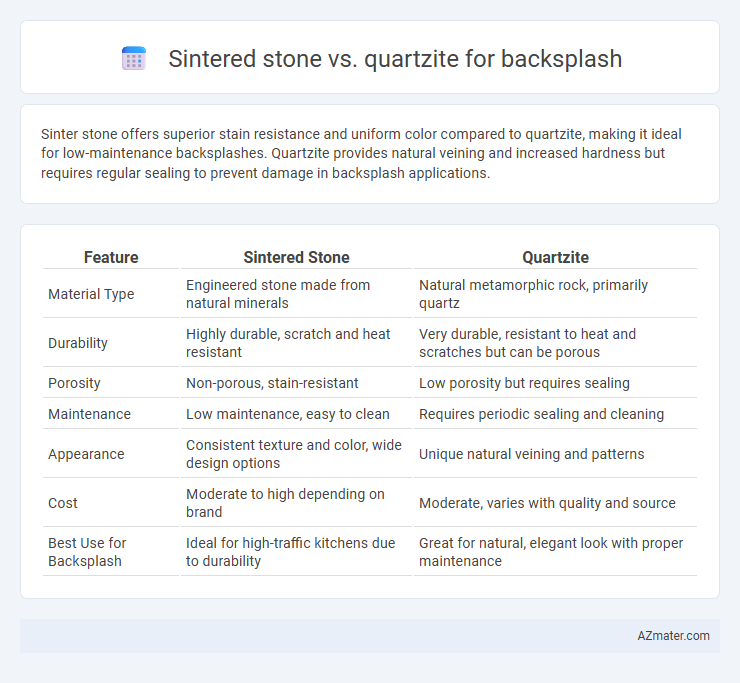Sinter stone offers superior stain resistance and uniform color compared to quartzite, making it ideal for low-maintenance backsplashes. Quartzite provides natural veining and increased hardness but requires regular sealing to prevent damage in backsplash applications.
Table of Comparison
| Feature | Sintered Stone | Quartzite |
|---|---|---|
| Material Type | Engineered stone made from natural minerals | Natural metamorphic rock, primarily quartz |
| Durability | Highly durable, scratch and heat resistant | Very durable, resistant to heat and scratches but can be porous |
| Porosity | Non-porous, stain-resistant | Low porosity but requires sealing |
| Maintenance | Low maintenance, easy to clean | Requires periodic sealing and cleaning |
| Appearance | Consistent texture and color, wide design options | Unique natural veining and patterns |
| Cost | Moderate to high depending on brand | Moderate, varies with quality and source |
| Best Use for Backsplash | Ideal for high-traffic kitchens due to durability | Great for natural, elegant look with proper maintenance |
Introduction to Sinter Stone and Quartzite
Sinter stone, a dense, non-porous engineered material, offers exceptional durability and resistance to stains, heat, and scratches, making it ideal for kitchen backsplashes. Quartzite, a natural metamorphic rock, provides a unique, elegant appearance with high hardness and heat resistance, but requires regular sealing to maintain its stain resistance. Both materials combine aesthetic appeal with practical functionality, catering to different preferences in kitchen design and maintenance.
Composition and Formation
Sinter stone, a natural mineral deposit formed from silica-rich waters in geothermal environments, boasts a dense, glassy texture due to rapid cooling and mineral crystallization. Quartzite originates from sandstone subjected to intense heat and pressure during metamorphism, resulting in a hard, crystalline structure primarily composed of interlocking quartz grains. The distinct formation processes influence their durability and appearance, with quartzite's metamorphic origin providing superior hardness and sinter stone offering unique translucency from silica deposits.
Appearance and Aesthetics
Sinter stone offers a sleek, uniform surface with subtle veining that lends a modern, minimalist elegance to backsplashes, while quartzite provides a more natural, varied pattern featuring intricate veining and a wide color spectrum that enhances rustic or traditional kitchen designs. Quartzite's natural crystalline texture reflects light differently across its surface, creating depth and visual interest, whereas sinter stone's smooth matte finish offers a consistent and contemporary aesthetic. Choosing between these materials depends on whether a clean, streamlined look or a richly textured, organic appearance is desired for the backsplash.
Durability and Strength
Sinter stone offers superior durability and strength for backsplashes due to its high resistance to scratches, heat, and stains compared to natural quartzite. Quartzite is a natural stone known for its hardness and resistance to wear, but it can be more porous and prone to etching and chipping over time. Selecting sinter stone ensures a longer-lasting, low-maintenance backsplash that withstands daily kitchen challenges better than quartzite.
Maintenance and Cleaning Needs
Sintered stone offers superior resistance to stains, scratches, and heat, making it ideal for a low-maintenance backsplash in busy kitchens, while quartzite requires regular sealing to prevent moisture and oil absorption. Cleaning sintered stone is straightforward with mild soap and water, avoiding harsh chemicals that can damage quartzite's natural surface. Quartzite's porous nature demands more vigilant upkeep to preserve its appearance compared to the durable, non-porous surface of sintered stone.
Heat and Stain Resistance
Sinter stone offers superior heat resistance, tolerating high temperatures without damage, making it ideal for kitchen backsplashes near stoves. Quartzite also provides excellent heat resistance but can be more prone to staining due to its natural porosity. For stain resistance, sinter stone's non-porous surface prevents absorption of oils and liquids, ensuring easier maintenance compared to quartzite, which may require regular sealing to protect against stains.
Cost Comparison
Sintered stone offers a competitive price point for backsplashes, typically ranging from $40 to $100 per square foot, which can be more affordable than quartzite, commonly priced between $60 and $120 per square foot. Installation costs for sinter stone are generally lower due to its lighter weight and ease of handling, whereas quartzite installation may require specialized labor, increasing overall expenses. Both materials provide durability and aesthetic appeal, but budget-conscious homeowners often prefer sinter stone for a more cost-effective backsplash solution.
Installation Process Differences
Sinter stone installation requires specialized cutting tools and expertise due to its hardness and density, often involving wet saws and diamond blades to prevent chipping. Quartzite, while also durable, is slightly less brittle and allows for easier cutting with standard stone-cutting equipment, making the installation process more accessible for contractors. Both materials need proper sealing after installation to protect against stains, but sinter stone's low water absorption reduces maintenance requirements compared to quartzite.
Environmental Impact
Sintered stone offers a lower environmental impact compared to quartzite due to its manufacturing process that uses natural minerals and minimal resin, reducing chemical emissions. Quartzite, being a natural stone, requires extensive quarrying, leading to higher energy consumption and habitat disruption. Choosing sintered stone for backsplashes promotes sustainability through durability, recyclability, and reduced resource extraction.
Which Material is Best for Your Backsplash?
Sinter stone offers exceptional durability and resistance to heat and scratches, making it an ideal choice for high-use kitchen backsplashes, while quartzite provides a natural, elegant appearance with unique veining patterns that enhance aesthetic appeal. Quartzite is slightly more porous and requires sealing to prevent stains, whereas sinter stone's non-porous surface offers easier maintenance and superior longevity. Choosing between sinter stone and quartzite depends on whether you prioritize durability and low maintenance or natural beauty and traditional stone texture.

Infographic: Sinter stone vs Quartzite for Backsplash
 azmater.com
azmater.com